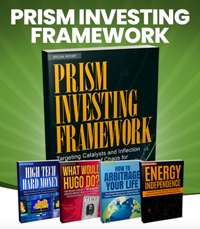 The September 2025 unemployment data from the Bureau of Labor Statics (BLS) was published last week. Its release was delayed by the government shutdown.
The September 2025 unemployment data from the Bureau of Labor Statics (BLS) was published last week. Its release was delayed by the government shutdown.
If you didn’t see it, the headline numbers appeared somewhat favorable. Nonfarm payrolls increased by 119,000. However, the unemployment rate still rose to 4.4 percent.
But if you squinted at the fine print. You found a number that was counter to the promise of a college education, and the expectation that it’s a golden ticket to gainful employment and a middle-class life. Specifically, a record 25 percent of all unemployed Americans now hold a four-year college degree.
On the flipside, this means 75 percent of the unemployed are without a college degree. Still, if you’ve invested four years and tens of thousands of dollars acquiring a college level education, you’d want the statistic to show that 100 percent of the unemployed are without a college degree.
In short, one in four people currently looking for work have done what they thought was the right thing. They spent four years, and likely a mountain of debt, pursuing an education. They thought this would be their golden ticket. It’s what worked for prior generations. Yet this is no longer proving to be true.
For the month of September, the unemployment rate for bachelor’s degree holders alone rose to 2.8 percent. This comes to over 1.9 million adults aged 25 and over without a job, a level we’ve never reached before this year. The safety net that a college degree once provided has a gigantic hole.
What to make of it…
Shifting Sands of the White-Collar World
College degrees in America have been the ultimate insurance policy for well over one hundred years. They offered a clear path from graduation cap to corner office, or at a minimum, a stable white-collar entry-level job. Now that path is obstructed by mud and ruts.
The unfavorable data isn’t just about the number of jobs. Rather, it’s about the actual landscape of the work itself. Professional services jobs, which have long been a sponge for new college grads, are contracting. These jobs experienced an outright decline in employment over the first nine months of 2025.
Meanwhile, the only two industries powering job growth are low paying Healthcare/Social Assistance and Leisure/Hospitality positions. By and large, these are not the dynamic, well-paying jobs people went to college for.
Why the sudden weakness for the educated class? The answer, we believe, is a single, two-letter acronym: AI.
The rapid integration of Artificial Intelligence into the corporate world is not just automating assembly lines. It’s automating many entry-level office tasks.
The work new hires do, like summarizing reports, entering data into spreadsheets, conducting routine market research, and customer service, is often repetitive grunt work. Generative AI is remarkably good at these mindless, repetitive tasks.
This is driving a white-collar employment slowdown that has never been experienced. Companies are recognizing they can achieve the productivity of a team of junior staffers with a subscription to an AI platform. No benefits need to be paid out. No holiday pay. AI bots never call in sick or take vacation days. They never file harassment claims with HR.
AI may not be killing all jobs – yet. But it’s eliminating many of the entry level positions.
The Experience Trap
Of course, if the entry level jobs are being eliminated how are young people ever going to gain the experience needed to reach a mid-career position? Where will they learn the important lessons that come from performing grunt work?
Young workers, in particular, are in the most trouble. The unemployment rate for those aged 20 to 24 climbed to 9.2 percent in September. This is a surge typically only seen during full-blown recessions. What’s more, it’s hitting a generation already burdened by crushing student loan debt.
For those fresh out of college, there’s a sense of betrayal and angst. This comes with the difficult realization that the rules they played by, and the sacrifice they made, were for a world that no longer exists. Now they’re standing in the exact same unemployment line as those who didn’t go to college. Only they’re carrying a five- or six-figure debt load.
In this unfortunate scenario, the diploma stops feeling like an achievement and starts feeling like an expensive receipt for a service that was never delivered. Then what?
When millions of educated, motivated young people – those we’re counting on to run the future – feel cheated and are unable to launch their lives, there are going to be problems. There’s already a sharp distrust in the finance system that profits from their debt, the educational institutions that charged them premium tuition, and the government that recklessly spends away their future.
When a generation loses faith in the promises of the past, that is the breeding ground for social instability and friction. Deep frustrations can quickly go from posting sad tweets to throwing bricks.
The safety net a college degree once provided has a gigantic, gaping hole. And the millions of young adults falling through it are going to have an extreme reaction.
Where Will All the Cubicle Dwellers Go?
If the four-year degree is no longer a golden ticket to gainful employment, then what is?
The reality is that the entire economic landscape is being remade. Like past transitions from the farm to the factory and then from the factory to the office, the AI transition is going to be messy.
This time it’s coming for the cubicle. So, where will all the cubicle dwellers go?
As the traditional first rung on the corporate ladder suddenly vanishes, a whole generation of youth are left stuck on the ground floor. If they can’t land their first entry level job, they can’t get the experience to land the second, better one. This thinning of the workforce will further the need for companies to double down on AI platforms, thus compounding the problem.
Some cubicle dwellers will take on gigs as a means for subsistence income. They’ll drive for Uber or Lyft. They’ll deliver food or rake people’s leaves. Others will rely on the benevolence of mom and dad well into adulthood, as they try and come up with a Plan B. Some may go into the trades.
Ultimately, where all the cubicle dwellers will go is unclear. But what is clear is that the economic landscape is dramatically changing and there’s no going back. A college degree, on its own, no longer delivers its promise. But AI isn’t the end all.
As far as we can tell, AI still cannot replicate critical and abstract thinking. It cannot replace genuine human creativity and real intelligence. It cannot start a business, establish relationships, develop a product line, bring it to market, and persuade people to buy it.
AI may be able to assist in these things and do them at a much lower cost than humans. But it cannot run point across the entire continuum that’s needed to create something from nothing and generate the associated wealth.
It still takes a real, living, breathing person to do that – college education or not.
[Editor’s note: Join the Economic Prism mailing list and get a free copy of an important special report called, “Utility Payment Wealth – Profit from Henry Ford’s Dream City Business Model.” If you want a special trial deal to check out MN Gordon’s Wealth Prism Letter, you can grab that here.]
Sincerely,
MN Gordon
for Economic Prism
Return from Where Will All the Cubicle Dwellers Go? to Economic Prism





AI is being used as an excuse to axe people.